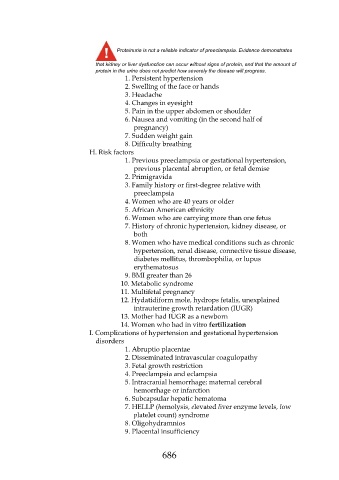Page 686 - Saunders Comprehensive Review For NCLEX-RN
P. 686
Proteinuria is not a reliable indicator of preeclampsia. Evidence demonstrates
that kidney or liver dysfunction can occur without signs of protein, and that the amount of
protein in the urine does not predict how severely the disease will progress.
1. Persistent hypertension
2. Swelling of the face or hands
3. Headache
4. Changes in eyesight
5. Pain in the upper abdomen or shoulder
6. Nausea and vomiting (in the second half of
pregnancy)
7. Sudden weight gain
8. Difficulty breathing
H. Risk factors
1. Previous preeclampsia or gestational hypertension,
previous placental abruption, or fetal demise
2. Primigravida
3. Family history or first-degree relative with
preeclampsia
4. Women who are 40 years or older
5. African American ethnicity
6. Women who are carrying more than one fetus
7. History of chronic hypertension, kidney disease, or
both
8. Women who have medical conditions such as chronic
hypertension, renal disease, connective tissue disease,
diabetes mellitus, thrombophilia, or lupus
erythematosus
9. BMI greater than 26
10. Metabolic syndrome
11. Multifetal pregnancy
12. Hydatidiform mole, hydrops fetalis, unexplained
intrauterine growth retardation (IUGR)
13. Mother had IUGR as a newborn
14. Women who had in vitro fertilization
I. Complications of hypertension and gestational hypertension
disorders
1. Abruptio placentae
2. Disseminated intravascular coagulopathy
3. Fetal growth restriction
4. Preeclampsia and eclampsia
5. Intracranial hemorrhage; maternal cerebral
hemorrhage or infarction
6. Subcapsular hepatic hematoma
7. HELLP (hemolysis, elevated liver enzyme levels, low
platelet count) syndrome
8. Oligohydramnios
9. Placental insufficiency
686

